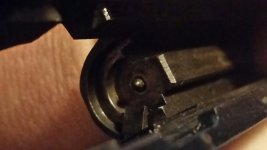Dieselhorses
Inactive
Hope this ended up in correct forum. Own an older (1991) 92 AF-D. Purchased it a couple of weeks ago. Given it's age, it's pretty tight but could use a face lift. Not exactly new to reloading but "new" to reloading 9 mm. Reloaded 50 rounds-4.5 gr Titegroup, Win spp, and 115 gr Montana gold jhp's with slight crimp and COL of 1.12 +/- .002. Upon examining spent cases I noticed a ripple/extrusion around firing pin mark. Primer didn't appear all that flattened but had me concerned. I examined the slide and firing pin of pistol but looked normal. Needless to say this is supposed to be a starting load via Hodgdon's data. No, I didn't try CCI primers yet but I will.




